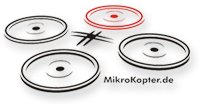Starting with the Mikrokopter
BR Here is the introduction to MK as translated fromBR http://www.mikrokopter.de/ucwiki/MikroKopterEinstieg BR BR IntroductionBR This page will provide a quick survey of the MikroKopter (MK).BR BR
MikroKopter History
On 24.10.2006 Holger Buss and Ingo Busker launched emerged very quickly a large town MikroKopter pilots. As early as mid-2007, the MikroKopter floated steadily as an air nail or agile as a small swallow through the air.BR BR The first year as video document including first flight BR BR In a short time, other components were added. So it is now possible to do semi-autonomous flights. The MikroKopter does tolerate enough burden for a camera, for example, or more sensors. For pilots, the sporty MK has enough agility to fly loops.BR BR
Brief Overview of the Mikrokopter
While reading some questions will certainly arise. Here are ways to have a fast answer:BR BR *Read the FAQ BR *Search the Forum BR *Read the 'After the building' MikroKopter BR *Create a theread in the Forum BR *Ask in IRC for simple questions. BR BR == Mikrokopter: Why? ==BR Why be member of the MikroKopter community? This question is not easy to answer. There are many projects that deal with Quadrocopters. All of them have their advantages and disadvantages. A plus point is certainly the great support from the large fan community. It tries to give each newcomer as much as possible to help. Maybe we should also ask: Why not? BR BR BR == Some theory ==BR It is often asked how can a Quadrocopter even fly. In fact, it's really quite simple. BR BR There are two different couples of rotors that run on Quadrocopters. The front and the rear propeller always run around right (clockwise), the left and the right propeller revolve around the left (anti-clockwise). To be able to float all four rotors must rotate at same speed. This raises the torque along the vertical axis through the different directions of rotation and the Quadrocopter is in the air. BR BR Now, to be able to fly in a direction , the copter is virtually out of balance. At the opposite direction of flight, the propeller speed increases, so that the copter into the flight direction tends. <<By now closed airflow propeller flies in that direction. Example: When is the next flight number of revs rear propeller.>> The Forward-Rear movement is known as "nod" or Nick. Right and left is called a "roll". BR BR Turning a Kopters around its own axis is known as the "yaw". For this movement, the torque to the axle changed. This is done by the speed of change always two opposing propellers. For a clockwise rotation, the speed of the left and the right propeller increased, while the front and rear lowered. For a turn in the opposite direction is obviosly the opposite. BR BR For a steady flight a costant adjustment is needed. This correcting action makes possible for the Mikrokopter to stay in the air. The sensor data are processed and calculated and the engines are activated accordingly (raising or lowering the revs speed). Most of all if situation is changed by external factors (such as wind). The scheme is in the software of the MikroKopter.BR BR BR <<< editing right now... >>>
